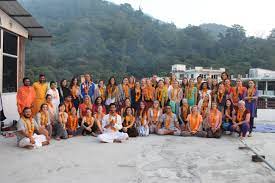The class of November 2016 congregated inside the top floor yoga hall of Rishikul Yogshala on a bright wintry day for the grand opening to another month of love, harmony, and good will. Some of our students had just arrived to the school and were still rapt in the beauty that is India. The yoga hall where so many of Rishikul Yogshala’s memorable months of learning and love unfolded was starting to feel like home to yet another batch of bright minds seeking the wisdom.

Some of them had already spent a month here in training for the 200 hour teacher training and now ready for the next step—the 300 hour course. They filled in the others, who were newly initiated to yoga and India, on the ritual about to commence. As they gathered around the fire-pit placed in the middle of the hall and conversations flourished, a foundation of camaraderie and fellowship was laid amongst this family of strangers hailing from different parts of the world.
We spoke to Terra— coming from the US, she was curious to find out what yoga meant in the land of its birth. She was inspired to teach but for her, the course was an opportunity to expand and improve personal practice.

Melanie, one of our esteemed students who completed her 200 hour training with us in the month previous had gained a more detailed insight on yoga in India. The element of breath, says Melanie, is an aspect much neglected in the yoga of the West. Learning in India helped her integrate breath and meditation with breath in her personal practice—a lesson she is inspired to take further with her 300 hour yoga teacher training this month.
Yulia, joining us this November from Israel confirmed her calling to yoga teacher training as something she definitely knew she would do at some point in life. The message of unity in yoga fascinated her. The way so many culturally different individuals congregated to learn and grow with yoga in India was a stuff of great wonderment for Yulia and she wanted to discover more.
Our principle yoga philosophy teacher, Shri Gangesha Chaitaniya, addressed the assembly and defined the significance of the fire ceremony. The fire placed in the middle of the congregation symbolized the purity and strength of the sun and the offering of the participants became a sign of reverence to this immense source of power. The priest chanted mantras invoking auspiciousness for all that struck a chord with everyone present there. Though unfamiliar to the ancient Sanskrit verses, the students were touched by the rhythmic singsong tone of the chant that is a universal language on its own. Listening to the verses proclaiming the glory of the Almighty as the remover of obstacles, the bringer of prosperity and joy and the one who withholds the energies of creation, preservation and destruction was meant to strengthen the participants.

They closed their eyes and breathed the air purified by the havan or the holy fire and were inspired to pray for things besides the material—the path to truth when they are in untruth, for the light when they are surrounded by darkness, and for courage when gripped by fear.




